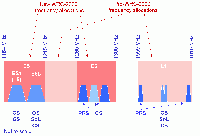If you wish to contribute or participate in the discussions about articles you are invited to contact the Editor
Galileo Open Service (OS)
| GALILEO | |
|---|---|
| Title | Galileo Open Service (OS) |
| Author(s) | GMV |
| Level | Basic |
| Year of Publication | 2011 |
The Galileo mission and services have been elaborated during the initial definition phase in consultation with user communities and the Member States. With positioning accurate to one metre, the freely accessible Galileo Open Service (OS) targets the mass market and is intended for motor vehicle navigation and location-based mobile telephone services. Free to the user, it provides positioning and synchronization information intended for high-volume satellite radio navigation applications. [1]
Purpose
The Galileo Open Service (OS) provides positioning, velocity and timing information that can be accessed free of direct user charge. This service is suitable for mass-market applications, such as in-car navigation and hybridisation with mobile telephones. The Open Service is accessible to any user equipped with a receiver, with no authorisation required. While up to three separate signal frequencies are offered within the Open Service, cheap single-frequency receivers will be used for applications requiring only reduced accuracy. In general, Open Service applications will use a combination of Galileo and GPS signals, which will improve performance in severe environments such as urban areas. The timing service is synchronised with UTC when used with receivers in fixed locations. This timing service can be used for applications such as network synchronisation or scientific applications.[2]
The Open Service does not offer integrity information, and the determination of the quality of the signals will be left entirely to the users. There will be no service guarantee or liability from the Galileo Operating Company on the Open Service.[3]
Performance and features
The Galileo Open Service is realized by using the signals at L1, E5a and E5b, whether data or pilot. Several combinations are also possible, such as a dual frequency service based on using L1 and E5a (for best ionospheric error cancellation) or single frequency services (at L1, E5a, E5b or E5a and E5b together) in which case the ionospheric error is removed using a model, and even triple frequency services using all the signal together (L1, E5a and E5b), which can be exploited for very precise, centimetric applications.[3].[4]
The performance objectives in terms of position accuracy and availability will be competitive with respect to existing GNSS and further planned evolutions. In addition, the Open Service will also be interoperable with other GNSS, in order to facilitate the provision of combined services. [2]
| Galileo Open Service (positioning & timing) | ||
|---|---|---|
| Single Frequency (SF) | Dual Frequency (DF) | |
| Coverage | Global | |
| Accuracy (95%) | Horizontal: 15 m | Horizontal: 4m |
| Vertical: 35 m | Vertical: 8m | |
| Availability | 99.8 % | |
| Timing Accuracy wrt UTC/TAI | N/A | 30 ns |
| Ionospheric Correction | Based on SF Model | Based on DF Measurements |
| Integrity | No | |
To know more information about Performances of each Galileo Service see the article Galileo Performances.
Implementation
The Open Service signals are separated in frequency to permit the correction of errors induced by ionospheric effects by differentiation of the ranging measurements made at each frequency. Each navigation frequency will include two ranging code signals (in-phase and quadrature). Data are added to one of the ranging codes while the other “pilot” ranging code is data-less for more precise and robust navigation measurements.
During the Initial Operational Capability (IOC) phase, the GALILEO open service, the search and rescue service and the PRS will be provided. At this stage, however, accuracy and availability will not yet have reached their optimum levels.[1]


